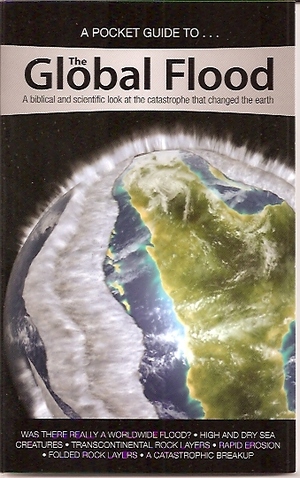In the American southwest, some particularly unique and dramatic landscapes have been preserved in the national parks. No one can fail to be impressed by the steep V-shaped gorge and the diagonal patterning (between horizontal erosion surfaces) which characterizes the rocks of Zion National Park in Utah. Similar sandstone rocks extend over a seven-state area, but they are not all called by the same name. In various parts of their range, these rocks are known either as Navajo, or Aztec, or Nugget Sandstone.
The interesting point is that these sandstone rocks extend over a tremendous area, variously estimated from 265,000 up to 660,000 square kilometres (Rahl et al. 2003. Geology 31#9 p. 761). In additional these deposits are very thick, up to 700 m (2200 ft) at Zion National Park and at lesser depths elsewhere. The total volume of these rocks is extremely large, perhaps as much as 10,000 cubic miles or 40,000 cubic kilometres. Concerning this stupendous extent of rock, some geologists call it “one of the largest sand seas known in Earth history.” (Loope and Rowe. 2003. Journal of Geology 111 p. 230).
Obviously there is nothing ordinary about the Navajo Sandstone. Naturally the first question many people ask is how this rock came to be laid down in its present location and form. The traditional explanation has always been that the diagonal layering (cross-bedding) is the result of wind action. The idea is that wind skimmed off the top of the sand dunes and deposited further dunes on top. Thus up, up, up the layers of sand were piled, with conspicuous erosion planes (flat cut-off surfaces) between the layers. This interpretation involving wind action, continues to be promoted, as in the Loope and Rowe article just cited above. Their focus is trackways and trampling on some buried rock surfaces.
The Navajo Sandstone, as a whole, has hardly any traces of plant or animal life, but there are a few sites of interest with some reptile footprints. The authors conclude that the areas with traces of life were actually wet at the time the organisms left their marks on the sand. These speculations involve an “ecological/ depositional system without modern analog” which would have developed under “unknown environmental conditions.” (p. 231) It is interesting that the authors have such difficulty explaining their observations. Perhaps there is a problem with their interpretive framework of wind deposited dunes.
The significance of the Loope and Rowe paper however pales into insignificance compared to the other article in 2003 to which we have referred. The full list of authors includes Rahl, Reiners, Campbell, Nicolescu and Allen. These scientists collected zircon crystals from two levels in the sandstone rock column, the higher of which was deposited almost 600 m (2000 ft) above the lower one. Thus these two collection sites, the one above the other, represent points near the top and bottom of the Navajo Sandstone rock layers.
These crystals, formed originally in granite rock, represent an important source of the radioactive elements uranium and thorium. Made of zirconium silicate, these hard crystals are very useful for studies involving radioactive decay. As the original granite rocks erode, many zircon and other silicate crystals end up in sedimentary deposits such as sandstone. In these sedimentary rocks, the zircon crystals, with their radioactive impurities, are useful indicators of the source rocks from which these products of erosion came. This is why these geologists set out to study zircons in the Navajo Sandstone. They wanted to know how far the sand grains had traveled to their final resting place in Utah.
To this end, the authors carried out two different analyses on the same zircon crystals. One analysis by itself might indicate a range of possible source sites, but two tests should narrow the field of possibilities. What indeed happened was that the two analyses narrowed the field to one astonishing rock source.
The analyses which were carried out included the ratio of parent radioactive uranium to stable daughter element lead, and secondly the quantity of helium left in the crystals from such radioactive decay. These tests served to rule out the nearby Rocky Mountain area as a source of the eroded crystals. Imagine the surprise of the investigators when they found that the dual signatures in their crystals suggested that the Appalachian Mountains on the northeast coast of North America, were the likely source of the sediments.
As a result of their analysis, the authors conclude that about two-thirds of the Navajo Sandstone came from the east coast, perhaps as far north as Nova Scotia in Canada and as far south as the Carolinas. Two-thirds of 40,000 cubic kilometers is 26,000 cubic kilometers of sediment. That is a lot of sand! Obviously the question arises as to how all this sediment came to the American southwest, thousands of kilometres away. In response, the authors declare that there was a sediment-dispersal system “fundamentally different from the modern one.” (p. 763) No kidding!
This scientific team suggests that there were a number of Amazon-size rivers which carried the products of erosion westward. Later, they suggest, wind moved the deposits south into their final resting site. The cross-bedding pattern in the rocks shows us that the sand was spread by an energetic process. Wind generated sand dunes however do not work as an explanation. The wind does not shear off the top part of the dune, thus depositing a new layer above the old one. (This had to happen if a cross-bedding pattern was to be produced.) Sand dunes move en masse.
Alternatively, sand waves, generated under extremely energetic water currents, do provide a reasonable explanation for our observations of cross-bedding. Studies conducted in highly energetic water currents such as San Francisco Bay, and in laboratory simulations (with flumes), indicate that sand waves can withstand horizontal sheering and deposition of another layer on top. A typical cross-bedding pattern is generated when deep sediment laden water moves, throughout its depth (not just on the surface), at 1 m or more per second.
Calculations based on laboratory-generated data suggest that a typical cross-bedded layer (about 5 m wide) in the Navajo Sandstone, was originally deposited as a 10 m high (33 ft) sandwave. The top part of the initial sandwave was then sheered away by the next, which left a similar 5 m cross-bedded layer. To drop such deposits, the water had to be about 54 m (180 ft) deep and moving at 1.5 m/second (3-5 ft/second). The inclined beds suggest that this huge body of water moved from the northeast toward the southwest. (For discussion of sandwaves, see Steven Austin. ed. 1994 Grand Canyon: Monument to Catastrophe. pp. 33-35 and Nick Eyles. 2002. Ontario Rocks: Three Billion Years of Environmental Change. pp. 50-53.)
Who needs several Amazon-size rivers when one gigantic flood is able not only to erode the sediments from the Appalachian Mountains (formed early in the flood), but also to move these sediments briskly westward and finally, to deposit them as sand waves over an extensive part of the American southwest. Such a uniform deposit had to be laid down from one huge body of water. Neither lake systems nor rivers yield so uniform a deposit.
Such current studies serve to emphasize the scale of devastation in the past. They do not paint a pretty picture of past events, but they do encourage us to reflect on the situation which lead to this terrible cataclysm. It is enough to make us count our blessings that we live now, and not then.
Margaret Helder
October 2004
Subscribe to Dialogue







